Detective fiction was growing in popularity when London publisher George Newnes decided to launch a new magazine in 1890. The very first issue, dated January 1891, led with the detective story “A Deadly Dilemma” by Canadian author Grant Allen. Over the next six decades, The Strand Magazine would feature a host of fictional sleuths, most notably Arthur Conan Doyle’s Sherlock Holmes and Agatha Christie’s Hercule Poirot. This blog post will look at some of the lesser-known detective stories published in The Strand in its early years, with images from original issues in the Victorian and Edwardian Collections.
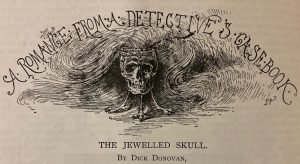
The Sherlock Holmes stories later collected as The Adventures of Sherlock Holmes and The Memoirs of Sherlock Holmes appeared in the July 1891 through December 1893 issues of The Strand. Prior to Sherlock Holmes, the most popular fictional detective of the day was “Dick Donovan,” the creation of J. E. Preston Muddock. Dick Donovan stories were issued alongside Sherlock Holmes stories in 1891 and 1892 issues of The Strand.
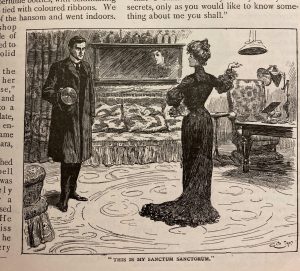 Writer L.T. Meade (Elizabeth Thomasina Meade Smith) teamed up with a medical doctor, Clifford Halifax, to create a series of mysteries solved with knowledge of medicine and psychology, entitled “Stories from the Diary of a Doctor.” The first series ran in 1893 alongside Memoirs of Sherlock Holmes stories and the second series ran in 1895. Meade would create a second popular detective series for The Strand in 1902-03, featuring a female criminal mastermind named Madame Sara, “The Sorceress of the Strand.”
Writer L.T. Meade (Elizabeth Thomasina Meade Smith) teamed up with a medical doctor, Clifford Halifax, to create a series of mysteries solved with knowledge of medicine and psychology, entitled “Stories from the Diary of a Doctor.” The first series ran in 1893 alongside Memoirs of Sherlock Holmes stories and the second series ran in 1895. Meade would create a second popular detective series for The Strand in 1902-03, featuring a female criminal mastermind named Madame Sara, “The Sorceress of the Strand.”
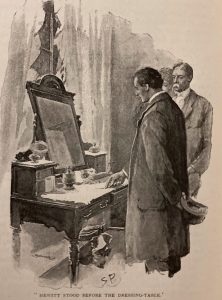 In 1894, Arthur Morrison’s detective Martin Hewitt kept readers interested in the absence of Sherlock Holmes. The stories were designed to be similar but different enough from Doyle’s; there is a Watson figure, a journalist named Brett. The Hewitt and Holmes mysteries even shared the same illustrator, Sidney Paget. Morrison published additional Martin Hewitt stories in Windsor Magazine, a competitor to The Strand, throughout 1895.
In 1894, Arthur Morrison’s detective Martin Hewitt kept readers interested in the absence of Sherlock Holmes. The stories were designed to be similar but different enough from Doyle’s; there is a Watson figure, a journalist named Brett. The Hewitt and Holmes mysteries even shared the same illustrator, Sidney Paget. Morrison published additional Martin Hewitt stories in Windsor Magazine, a competitor to The Strand, throughout 1895.
Grant Allen introduced two women detectives to readers of The Strand in 1898-99: Miss Cayley, a single woman who solves crimes while traveling through Europe, and Hilda Wade, a nurse with a photographic memory. Allen dictated the final episode in the Hilda Wade series to Doyle on his deathbed. Other notable mystery content in early volumes of The Strand includes stories featuring gentleman criminals by popular writers Benjamin Farjeon and Florence Warden.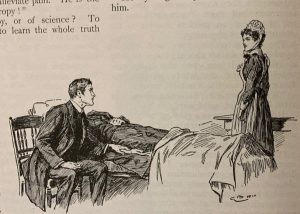
Looking to read some of these stories? Many of these detective series were gathered and published in book form. Oxford University Press published an anthology of the best Detective Stories from “The Strand” in honor of its centenary in 1991. And you can find links to digitized copies of The Strand in the library’s catalog through the Lee Library’s membership in HathiTrust.
November 30, 2020 by Ben Harry
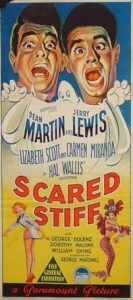
To find options to see SCARED STIFF, you can look at streaming options HERE since we couldn’t find a disc at any local library.
There’s something rotten on Lost Island, or at least something haunted. Dean Martin and Jerry Lewis inadvertently agree to help the beautiful Lizabeth Scott return to her ancestral homeland off the coast of Cuba and hilarity ensues. Martin stows away in Scott’s trunk when pursued by the police for a murder he did not commit. Then, Lewis stows away in the same trunk when mobsters seeking revenge for the mob boss’s philandering girlfriend fingers his character. Along the way a real mystery ensues as Scott’s island is shown to contains an enormous treasure. These situational events showcase the comedic and singing talents of what had become the famous Martin and Lewis team.
Viewers of the film will be led along by the frenetic pace of the story, jumping from one set of problems to another all because of Martin and then made worse by Lewis. If any moment becomes a little too serious, or romantic, between Martin and Scott, Lewis appears with a host of related difficulties made worse by his slapstick attempts to help. Motivations aside, Lewis as the actor is trying to be as irritating to the film goer as possible without actually turning them off to the film, which in turn makes Martin seem all the more smooth and debonair by comparison.
One scene to watch for in the film is when the two are pressed into service on the boat ride to Cuba to pay their passage. Martin sings, while Lewis “ruins” the show, in the same fashion as many of their live performances. It is a way of seeing them on stage without going to the clubs along the East Coast they were famous for playing. In these scenes you’ll also see the famous Brazilian samba singer Carmen Miranda, in her final film appearance before a fatal heart attack. It was a fitting coda for the 1940s film and music star.
Dean Martin and Jerry Lewis shared the professional spotlight as a team for only ten years, but what a ten years it was. Seventeen film appearances, their own television show on the fledgling NBC network, five years as the stars of their own radio program and countless club shows along the way. As fate would have it, their last club appearance on 25 July 1956 at the Copacabana Club in New York came exactly ten years to the day after their first show in Atlantic City. And, like much of their stage act appeared, being thrust together in 1946 was accidental, when Lewis suggested to the club manager Martin take the place of the absent regular club singer. The rest quickly became history.
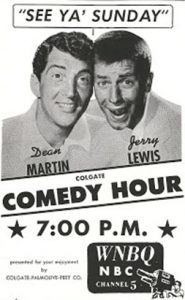
Behind the scenes, and thankfully outside of the viewers enjoyment, the duo was in trouble. They didn’t want to make the film, with Martin in particular feeling like the story wasn’t very original. However, Paramount held them to their contract and filming took place in June and July 1952. Released in April 1953, it was a financial success for the studio and the actors. Tension between the two stars percolated beneath the surface during the filming and for another four years, until their sudden break immediately following the show. In later years neither could readily identify a reason, but Lewis said they didn’t talk privately for twenty years.
For After the Movie:
There is a double homage embedded within Scared Stiff, both revolving around Bob Hope. You’ll remember when confronted by Mr. Ortega, the mysterious and ultimately mortally dangerous antagonist of the film, Dean Martin says he’s a ghost buster, like a trust buster, a bronco buster, or a gang buster. This may be the first time the term is used in film and inadvertently influenced the 1984 comedy, Ghostbusters. Dan Aykroyd credits the now more obscure Bob Hope and Paulette Goddard 1940 film, The Ghost Breakers, as inspiration for his iconic supernatural fighting team. Indeed, Scared Stiff is a thinly veiled remake of this earlier film.
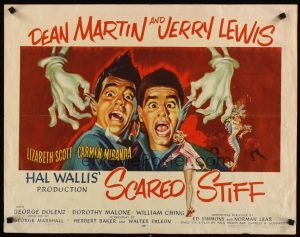
The second homage to Bob Hope is far more direct, as you saw just a few minutes before the film ended. While Scared Stiff was the eighth feature film for the Martin and Lewis duo, it is their ninth appearance on screen. They had appeared in the 1952 hit, The Road to Bali, in a brief cameo every film goer of the time would have recognized. A short two years later Hope and Crosby returned the favor.
Brian Wages, Reference Specialist
Harold B. Lee Library, Social Sciences
 The Lee Library recently digitized a well-known book of early modern English science: the 1633 edition of John Gerard’s Herball, or Generall historie of plantes (online at https://archive.org/details/herballorgeneral1633gera). Gerard was a surgeon and herbalist who curated the Royal College of Physicians’ garden of medicinal plants. He first published his herbal, which is a type of encyclopedia of plants focusing on their medicinal properties, in 1597. BYU’s copy of the 1597 edition is incomplete.
The Lee Library recently digitized a well-known book of early modern English science: the 1633 edition of John Gerard’s Herball, or Generall historie of plantes (online at https://archive.org/details/herballorgeneral1633gera). Gerard was a surgeon and herbalist who curated the Royal College of Physicians’ garden of medicinal plants. He first published his herbal, which is a type of encyclopedia of plants focusing on their medicinal properties, in 1597. BYU’s copy of the 1597 edition is incomplete.
Gerard took his text from a 1554 herbal by botanist Rembert Dodoens, but added his own observations and descriptions based on the plants he grew. Gerard’s herbal is the first to illustrate the potato (seen in the image above) and also contains information about rare plants cultivated in England. As was common, Gerard’s herbal is not organized alphabetically, either by the English or Latin plant names. It is indexed both by plant name and by the “virtues” or medicinal properties of the plants.
For more information on Special Collections’ early botanical books, see the “Brief History of Natural History” collections guide. Other examples can be found in the library catalog by searching on the subject term “Botany—early works to 1800.”
November 6, 2020 by Ben Harry

Short plot summary: Danny Kaye stars in this swashbuckling historical comedy musical. The farcical romp plays on the tradition of historical adventure films like The Adventures of Robin Hood in an airy manner that delights and entertains on multiple levels. The kingdom has been usurped by a murderous interloper and Danny Kaye’s outlaw minstrel seeks to place the rightful child heir in his correct place. A case of mistaken identity leads to his infiltration of the castle and his perilous intrigue to dethrone the imposter. Of course comedy ensues as nothing goes as planned!
The songs are hilarious: Pay close attention to the musical lyrics in each song as they were so cleverly constructed. It really is a lot of fun.
Life Could Not Better Be – this opening number sets up the entire trajectory of the farcical nature of the film as our minstrel sings about the film to come, the generic background it will play against, and specifics of how they spared no expense in their research.
Outfox the Fox is my personal favorite song in the film, and the whole number is cleverly choreographed and is a hoot that doesn’t wear out its welcome on repeat viewings.
The Maladjusted Jester is a wonderful song that even poignantly outlines the role of the comedian in times both historical and modern. They truly make their way by making fools of themselves.

Technical specs: Released in technicolor and in the widescreen VistaVision format. VistaVision was not an anamorphic widescreen process, but it flipped the 35mm film sideways so that stretching and compressing were not needed. This yielded higher quality visuals, and although it was short-lived (only about seven years) films still used it for special effects sequences for decades to come.

What was going on in cinema history when this was produced?
Boy, do I feel stuck in a particular time, with all of my suggestions this fall coming from the same era. This film came out in December of 1955, just before Christmas, but only in Japan. It came out in January in the U.S., so I wasn’t even sure what year to put after the film’s title. We will say 1955, but it was released domestically near the end of January 1956. Compared to my other two suggestions this fall, Forbidden Planet and Invasion of the Body Snatchers, all three of these came out within a year of each other. In this era there WAS a significant revival of historical costume dramas to showcase technological improvements and differentiate cinematic thrills from TV production. As mentioned in the earlier reviews from the mid-1950s, probably the most successful genre was the large-cast musicals. Against this backdrop the creators were inspired to lay bare all the conventions of these two types and play against them in a comical way.
This era in the 1950s is marked by the creative break from many of the norms established in the 1930s and 1940s. The Classic Hollywood style and genres were established during those two decades, and are beloved to this day, but in the 1950s there were creative movements to break out of conventions. The space movie, the absolute panic of the Body Snatchers, and now the farcical playing with genre were a result. I certainly love this post-classical era as well.
So please, enjoy the movie now. This is one of my family’s favorites that all of us of any age can enjoy.

Where is it available? Public libraries should have it: Orem has multiple copies confirmed (here 1LINK and 2LINK), Provo as well, the BYU library has more than one copy for those who have privileges, and for streaming rental or purchase it is available on YouTube, on GooglePlay, and Amazon.
For AFTER the Movie:
I hope you enjoyed the film as much as I do. The hypnotic back and forth gets everyone laughing and is a highlight for all screenings. The magnetic pulling of the helmet from Griswold’s hands is a most beautiful comedic moment in cinema. The repeated threats of Angela Lansbury to throw herself from the highest tower, and the repeated displaying of the baby’s behind are some of my favorite parts.
It really turns the genre on its head to have our hero NOT be Errol Flynn-type, but the one who cannot swordfight, who is a nursemaid, and shies away from killing and fighting. But a hero he is nonetheless. Glynis Johns did a terrific job in a fun role where her role must take on many of the genre’s conventional hero duties.
While the film was a commercial bomb the first time through, it has since been recognized as a comedy classic, and I hope you will agree.
Trivia
This was the most expensive comedy up to this time. Typically, comedies were inexpensive to make because they often require relatively small casts and minimal sets. But in order to appropriately lampoon a “big budget” historical adventure/drama and “big budget” musicals it was requisite that they still invest in horses, elaborate costumes, full-scale sets, and a large cast. The budget for the picture then was very similar to what would be typical for this genre, running up to over $4 million in 1955, adjusted for inflation that would be almost $39 million for today! The film was considered a flop, because it only earned back $2.2 million in the box office (21.5 million today).

Basil Rathbone was an excellent swordsman. Danny Kaye was not. Kaye’s comical sword fighting performance was so manic and haphazard that he diverged widely from rehearsed steps and almost skewered Rathbone multiple times during their exchange. Rathbone has stated that it was only due to his quick prowess that he wasn’t injured and that he was truly fighting for his life out there when the audience is laughing in the aisles.
I sincerely hope you have enjoyed this king of movies and movie of kings!
Ben Harry, Curator
BYU Motion Picture Archive
November 4, 2020 by Ryan K. Lee
 It’s that time of year again! Our annual “History of Doctrine and Covenants” exhibit is on display now in L. Tom Perry Special Collections. This exhibit takes the viewer through the history of the Doctrine and Covenants, from handwritten manuscripts to being published in book form in 1835. Later editions with significant additions or deletions are also displayed, including the 1845 edition (added the section on the martyrdom of Joseph and Hyrum Smith in 1844), the 1879 edition (footnotes added by Orson Pratt and added Section 132 on plural marriage), and the 1921 edition (removed the Lectures on Faith, which had been there since 1835). Also shown is an 1835 letter from Oliver Cowdery to Newel K. Whitney regarding original copies of a revelation, and James E. Talmage’s journal where he documents revisions he was asked to make in 1921 as part of the Doctrine and Covenants Committee.
It’s that time of year again! Our annual “History of Doctrine and Covenants” exhibit is on display now in L. Tom Perry Special Collections. This exhibit takes the viewer through the history of the Doctrine and Covenants, from handwritten manuscripts to being published in book form in 1835. Later editions with significant additions or deletions are also displayed, including the 1845 edition (added the section on the martyrdom of Joseph and Hyrum Smith in 1844), the 1879 edition (footnotes added by Orson Pratt and added Section 132 on plural marriage), and the 1921 edition (removed the Lectures on Faith, which had been there since 1835). Also shown is an 1835 letter from Oliver Cowdery to Newel K. Whitney regarding original copies of a revelation, and James E. Talmage’s journal where he documents revisions he was asked to make in 1921 as part of the Doctrine and Covenants Committee.
This exhibit will be on display in the Reading Room in Special Collections until the end of 2020. Come see this popular exhibit and learn more about this significant book of modern day scripture!
Note on restrictions due to COVID-19: Because this exhibit is in our Reading Room and we have to limit the amount of people in the room, visitors will only be allowed in one person at a time to view the exhibit.
NEW THIS YEAR! Knowing that many may not be able to see this exhibit in person for various reasons, we have created an online version of this exhibit: https://historyofdc.lib.byu.edu/. This includes additional content not found in the physical exhibit, including information about The Evening and Morning Star (1832) and the Book of Commandments (1833).
October 30, 2020 by Ben Harry

This film is available in the collections at the Harold B. Lee Library, Provo City Library at Academy Square and the Orem Public Library.
The Amazon River is home to a dark and foreboding creature, a remnant of prehistoric times and one who is haunting an expedition deep into the Brazilian interior. The mysterious and forbidding Black Lagoon provides more than the expedition bargained for as viewers in 1954 watched the creature shadow their every move. The suspense wasn’t, however, for the viewers, but for the expedition as the director skillfully built the tension in the film by allowing them to see what could be coming next. Cinematically, the film was among Jack Arnold’s best, as we see the creature swimming below the unsuspecting Julie Adams.

The Creature and Julie Adams
Two actors portrayed the creature, dubbed “Gill-man” by fans. Professional swimmer Ricou Browning was the underwater creature, wearing a lighter and more flexible suit. To maintain the illusion of a fishlike creature, Browning was required to swim while holding his breath, sometimes for up to four minutes. While out of water, the creature was played by Ben Chapman, in a heavy and less form-fitting costume. It is the single most important role in his career, and no one ever saw his face.
Although the film was successful, it didn’t catapult many of the cast or crew to greater success. Director Jack Arnold worked on a few films after The Creature from the Black Lagoon, but then turned to television before the decade was over and counted such series as Gilligan’s Island and The Brady Bunch in his repertoire. Richard Carlson, playing the leader of the expedition, also moved to television where he became a staple among the character actors. Julie Adams became a staple among television, a career spanning over forty years and even appearing an episode of Lost in 2006,
While the idea of a half-fish, half-man monster was conceived ten years before the film, the actual creation fell to the costume and make-up department at Universal, led by the pugnacious Bud Westmore. For nearly a half century he would claim the creature was his creation, but it was in fact the work of Milicent Patrick, a former Disney animator. In addition to helping to visualize the creature, she worked on such notable films as It Came from Outer Space (1953) and This Island Earth (1955). Universal was so impressed with her work the studio sent her on a press tour to promote The Creature from the Black Lagoon, a move which infuriated Westmore. Upon returning from the initial leg of her tour, dubbed “The Beauty Who Created the Beast” he fired her and immediately claimed credit for the creature’s creation. It was not until the 1970s when an article by Forrest Ackerman revealed her work on the creature and again in 2019 with the publication of Mallory O’Meara’s book titled The Lady from the Black Lagoon was Patrick’s critical contribution to the film properly documented.

Milicent Patrick and The Creature
The success of the original film led to two sequels. In Revenge of the Creature (1955), the captured creature, now housed at an oceanarium in Florida, is again enamored with a beautiful woman. After an escape from his cage with said woman in unwilling tow, he is shot only to sink into the ocean as the film ends. While not a critical success, one of the more interesting trivial moments of the film is the screen debut of Clint Eastwood in an uncredited role as a lab technician. This sequel was followed by The Creature Walks Among Us (1956), which, lacking the cinematic and screenwriting skill of the original film, introduced the proposition of the creature becoming more human as it begins shedding its gills. With the conclusion of this film, some have said it marked the end of the Universal’s classic monsters series, launched in 1925 with the silent classic, Phantom of the Opera.
We hope you enjoy the beauty and chills of The Creature from the Black Lagoon.
Brian Wages, Reference Specialist
Harold B. Lee Library, Social Sciences
 A temporary exhibit in Special Collections’ lobby showcases creepy and mysterious book cover designs in time for Halloween. “Thrills and Chills in Cloth” features British and American cloth bookbindings from the late 19th and early 20th centuries.
A temporary exhibit in Special Collections’ lobby showcases creepy and mysterious book cover designs in time for Halloween. “Thrills and Chills in Cloth” features British and American cloth bookbindings from the late 19th and early 20th centuries.
In the late 1880s, book manufacturers developed a process to stamp bookcloth with colored ink. Publishers used this technology to issue books with stylized, pictorial covers which were decorated by block stamping the cloth covered boards. The designs on display reflect the spooky, mysterious, or creepy-crawly content of the pages inside — such as this example, issued by London publisher Arthur Pearson in 1899. The cover recreates a portion of an illustration inside the book, by artist Benjamin E. Minns.

“Thrills and Chills in Cloth” will be on display through the end of October.
October 14, 2020 by Maggie Kopp •
exhibits
 A major exhibit featuring the Rare Japanese Books collection opened this week. Discovery & Wonder: The Harry F. Bruning Collection of Japanese Rare Books and Manuscripts was curated by Professors Jack Stoneman and Aaron Skabelund and will be on display in Special Collections’ main gallery on level 1 of the library throughout the 2020-2021 academic year. The exhibit includes a number of important items from BYU’s collection and tells the story of how they came to the HBLL.
A major exhibit featuring the Rare Japanese Books collection opened this week. Discovery & Wonder: The Harry F. Bruning Collection of Japanese Rare Books and Manuscripts was curated by Professors Jack Stoneman and Aaron Skabelund and will be on display in Special Collections’ main gallery on level 1 of the library throughout the 2020-2021 academic year. The exhibit includes a number of important items from BYU’s collection and tells the story of how they came to the HBLL.
More information about this exhibit and images from the gallery can be found at the HBLL news blog. For those who can’t visit the library in person, a catalogue will be available in the near future.
October 9, 2020 by Ben Harry
My pick for this month is: Invasion of the Body Snatchers (1956)
Where is it available? This is quite a popular title, so public libraries should have it (Orem is confirmed), the BYU library has a copy for those who have privileges, and for streaming rental or purchase on YouTube, on GooglePlay (least expensive), and Amazon.

Plot
Dr. Miles Bennell shares his terrifying account of “pod people” taking over his town in fictional Santa Mira, California. Unraveling as a flashback, you can feel the world closing in as people all around Miles start acting a little bit unhuman . . .
Background
Allied Artists Pictures Corporation, formerly Monogram Pictures, which was known for their low-budget adventure films, released this film in early February of 1956. That was only one month before the release of my pick from last month, Forbidden Planet. (This is a coincidence, I promise!) But it was from the same cultural ecosystem as Planet that Invasion will spawn. But both are excellent examples of developing cinematic atmosphere. Shot in a simple matted widescreen format and in black and white, it had no ambitions of distraction, but aimed for a slowly building panic-induced viewer engagement that left you sitting forward in your seat. For further comparison between the two, if Planet felt like a precursor to Star Trek, then Invasion would be an embryonic Twilight Zone episode.

Favorite bits to watch for
I love the film noir elements of this film. Certainly most-associated with the crime and detective films of the era, the adaptation of tools such voice-over-flashback, dimly-lit settings, and a femme fatale to the science fiction drama works surprisingly well. A doctor is our detective searching for clues to decipher what is going on, and despite the framing story we the audience unravel the mystery only as our characters do. Maybe my love for detective noir AND science fiction lead me to love the mix in this one.

This film is all about the experience. It needs to be viewed in an undistracted 90 minute window in a dark room. So please, leave the rest of this article for after the movie (if you are going to watch it) so that none of it is painted by the things I will tell you from here on out. Enjoy!

For after the show
Boy, does this film move fast in its pacing, the mystery absolutely driving from scene to scene. It is incredibly lean and economical, quickly telling us the what, where, why, when, and how with very little elaboration beyond just what we need to know. This works perfectly for the development of the suspense as there is no drawn out explanations of our lead-couple’s past or the details of alien invasion. We know just enough to root for the romantic couple, just enough to make us feel for the loss of humanity in the town, and just enough to feel the shock down our spine with that last kiss!
This economy probably stems somewhat from the skills and experience of the films director, Don Siegel. Mr. Siegel began his career in the montage dept. at Warner Bros. There he was tasked to cut together sequences that would convey as much as possible in very short montage sequences, condensing images and lines. He is credited for the opening montage in Casablanca, and he won two Academy Awards in 1945 for two different short films. Truly his craft was in making the most of condensed time in the world of the film.
This film is also a great testament to the level of talent and craft in Hollywood in the 1950s. The excellent lighting, camera work, special effects, and acting belie the shoestring budget with which this was produced. The scenes are long and let the actors act when we need to be drawn into the moment, yet the pace of mounting suspense is maintained throughout. It is a prime example of great technical filmmaking!
It’s aims are modest, yet it achieves them so resoundingly that it works very well.
Adapted from a 1955 serialized story by Jack Finney, this film version tapped into the cold war zeitgeist of paranoia centered on ideological philosophies rendering our friends, family, and neighbors unrecognizable. Whether that change was to conspiracy-crazed anti-communism, or in the exact opposite direction of embracing soulless Marxism, the lens of others becoming “unfeeling pod people” could be adapted to either interpretation. Treatises supporting each interpretation have been penned, so it is truly a Rorschach test – where what you see in the ink blots is what you bring with you inside. We could certainly link the current mistrust and paranoia of the current pandemic that is moving unseen through human carriers today in 2020 as well!

Production tidbits
As with Planet from last month, the studios’ big budgets are going to feel-good spectacles and musicals, yet there is a disturbed undercurrent in the low-budget offerings of more pessimistic fare. In some markets, Invasion was coupled on a double bill with the lesser sci-fi thriller Timeslip or Atomic Man from Britain. Truly it was trolling for a different audience than the A-pictures. But this was a modest hit, making back ten times its production cost.
Initially, producer Walter Wanger was hoping to cast recognizable talent for the roles. His list for Miles Bennell consisted of Dick Powell and Joseph Cotten. For Becky, he envisioned Anne Bancroft, Donna Reed, or Kim Hunter, among others. But with a constricted budget, he had to search lower salaries and found Kevin McCarthy and Dana Wynter. Kevin McCarthy followed director Don Siegel from their recent collaboration An Annapolis Story (1955) the previous year. Although it would have been great to have such actors, I also feel that the casting of unrecognizable faces works really powerfully in this film as they come off as people that could truly be your neighbors.
The film’s title changed a few times during production. Initially, it was to have the same title as the source material by Jack Finney, The Body Snatchers. But in 1945 there was a Robert Wise/Val Lewton production of that name in the singular, so they didn’t want it to be confused as a re-release. The film continued to rotate through They Come from Another World, Better Off Dead, Sleep No More, Evil in the Night, and World in Danger before finally coming around just about full circle to Invasion of the Body Snatchers. Which has become its own pop culture root for all sorts of Invasion of… titles for films, books, TV episodes, and so forth.
My favorite fun-fact
One of the promotions at theaters in the U.S. was displays of giant paper mache pods in lobbies and other entrances.

Ben Harry, Curator
BYU Motion Picture Archive
September 29, 2020 by Ben Harry
This film, which was never copyrighted, is in the public domain and readily available online through such platforms as YouTube. It is also available in the Harold B. Lee Library, Provo City Library at Academy Square and Orem Library.
Abbott and Costello. Martin and Lewis. Crosby, Hope and Lamour. For movie goers of the 1940s and early 1950s, the trio of Bing Crosby, Bob Hope and Dorothy Lamour were among the most recognizable names on the silver screen and by 1952, they’d appeared in five “Road to” films, traveling to such exotic places as Singapore, Zanzibar, and Rio. Exotic locations became the convenient foils for the comedic antics of these three entertainers and The Road to Bali is no exception.

Situational comedy is the plot, as Harold (Bob Hope) and George (Bing Crosby) are found in ever more extraordinary circumstances. As dancers and singers they are quickly forced to escape from Melbourne, Australia to avoid humorous marriage proposals. Later hired as deep-sea divers, they are taken to Bali where they compete for the romantic attentions of Princess Lala (Dorothy Lamour). She, however, can’t decide who she loves more and then with treasure on the line, the three escape to another island. There she discovers among the natives she can take multiple husbands, which they all agree. Further high jinx ensues when Crosby and Hope are mistakenly married to each other and a volcano god becomes angry with such an arrangement and initiates an eruption. With such incredulous plot twists, one wonders if 1990’s Joe Versus the Volcano (staring the duo of Tom Hanks and Meg Ryan) is an homagic spoof.
The Road to Bali is significant in its violation of the fourth wall, inviting the audience to participate in the story. Two instances display Hope’s comedic talent. As Crosby is about to beginning wooing Lamour, Hope turns to the camera and says “He’s about to sing. You may as well go and get some popcorn!” In some reports, this was a popular time for kids to get up and purchase snacks, much to the chagrin of Crosby. Then, as the film ends, Hope, after losing to Crosby the love of Lamour, is able to conjure up the iconic sex symbol of Jane Russell after playing a flute over a large basket. Unfortunately for him she quickly falls in love with Crosby and he is left on the beach pining to the audience to extend the film to see what will happen next. This invitation to the audience acknowledges how endearing the trio had become to the American audience throughout the series of films.

With a box office gross of about $3 million, The Road to Bali was the least financially successful film of the franchise after the initial Road to Singapore. It also just barely missed out on the top ten grossing films of the year, losing out to such classics as The Quiet Man, Ivanhoe, and Cecil B. DeMille’s epic The Greatest Show on Earth.
When it was released in 1952, the well-known Crosby and Hope were financially successful, investing in numerous ventures outside of Hollywood. During the film, the inside jokes continued, which many viewers would have recognized. Watch for Crosby to make side references to the major league baseball franchises of Pittsburgh and Cleveland. At the time of he was a minority owner of the Pirates while Hope was an investor in the Indians.
Although not the last of the “Road to” films, it was the last with all three stars. In 1962 United Artists and director Norman Panama tried one last time on the series with The Road to Hong Kong. Lamour, although she appears in the film, was replaced with much younger Joan Collins as the primary love interest. And, with this significant change, the “Road” magic was gone. A critical and financial disappointment, it marked the unfortunate end of the series and provided an unremarkable coda for Crosby and Hope as acting partners.

We hope you enjoy getting away with The Road to Bali.
Brian Wages, Reference Specialist
Harold B. Lee Library, Social Sciences

 Writer L.T. Meade (Elizabeth Thomasina Meade Smith) teamed up with a medical doctor, Clifford Halifax, to create a series of mysteries solved with knowledge of medicine and psychology, entitled “Stories from the Diary of a Doctor.” The first series ran in 1893 alongside Memoirs of Sherlock Holmes stories and the second series ran in 1895. Meade would create a second popular detective series for The Strand in 1902-03, featuring a female criminal mastermind named Madame Sara, “The Sorceress of the Strand.”
Writer L.T. Meade (Elizabeth Thomasina Meade Smith) teamed up with a medical doctor, Clifford Halifax, to create a series of mysteries solved with knowledge of medicine and psychology, entitled “Stories from the Diary of a Doctor.” The first series ran in 1893 alongside Memoirs of Sherlock Holmes stories and the second series ran in 1895. Meade would create a second popular detective series for The Strand in 1902-03, featuring a female criminal mastermind named Madame Sara, “The Sorceress of the Strand.” In 1894, Arthur Morrison’s detective Martin Hewitt kept readers interested in the absence of Sherlock Holmes. The stories were designed to be similar but different enough from Doyle’s; there is a Watson figure, a journalist named Brett. The Hewitt and Holmes mysteries even shared the same illustrator, Sidney Paget. Morrison published additional Martin Hewitt stories in Windsor Magazine, a competitor to The Strand, throughout 1895.
In 1894, Arthur Morrison’s detective Martin Hewitt kept readers interested in the absence of Sherlock Holmes. The stories were designed to be similar but different enough from Doyle’s; there is a Watson figure, a journalist named Brett. The Hewitt and Holmes mysteries even shared the same illustrator, Sidney Paget. Morrison published additional Martin Hewitt stories in Windsor Magazine, a competitor to The Strand, throughout 1895.



 The Lee Library recently digitized a well-known book of early modern English science: the 1633 edition of John Gerard’s
The Lee Library recently digitized a well-known book of early modern English science: the 1633 edition of John Gerard’s 




 It’s that time of year again! Our annual “History of Doctrine and Covenants” exhibit is on display now in L. Tom Perry Special Collections. This exhibit takes the viewer through the history of the Doctrine and Covenants, from handwritten manuscripts to being published in book form in 1835. Later editions with significant additions or deletions are also displayed, including the 1845 edition (added the section on the martyrdom of Joseph and Hyrum Smith in 1844), the 1879 edition (footnotes added by Orson Pratt and added Section 132 on plural marriage), and the 1921 edition (removed the Lectures on Faith, which had been there since 1835). Also shown is an 1835 letter from Oliver Cowdery to Newel K. Whitney regarding original copies of a revelation, and James E. Talmage’s journal where he documents revisions he was asked to make in 1921 as part of the Doctrine and Covenants Committee.
It’s that time of year again! Our annual “History of Doctrine and Covenants” exhibit is on display now in L. Tom Perry Special Collections. This exhibit takes the viewer through the history of the Doctrine and Covenants, from handwritten manuscripts to being published in book form in 1835. Later editions with significant additions or deletions are also displayed, including the 1845 edition (added the section on the martyrdom of Joseph and Hyrum Smith in 1844), the 1879 edition (footnotes added by Orson Pratt and added Section 132 on plural marriage), and the 1921 edition (removed the Lectures on Faith, which had been there since 1835). Also shown is an 1835 letter from Oliver Cowdery to Newel K. Whitney regarding original copies of a revelation, and James E. Talmage’s journal where he documents revisions he was asked to make in 1921 as part of the Doctrine and Covenants Committee.


 A temporary exhibit in Special Collections’ lobby showcases creepy and mysterious book cover designs in time for Halloween. “Thrills and Chills in Cloth” features British and American cloth bookbindings from the late 19th and early 20th centuries.
A temporary exhibit in Special Collections’ lobby showcases creepy and mysterious book cover designs in time for Halloween. “Thrills and Chills in Cloth” features British and American cloth bookbindings from the late 19th and early 20th centuries.
 A major exhibit featuring the
A major exhibit featuring the 







